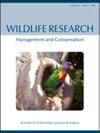遥感显示,昆士兰东南部的考拉(Phascolarctos cinereus)更喜欢在其活动范围内树冠高度较高的地区
IF 1.6
3区 生物学
Q3 ECOLOGY
引用次数: 0
摘要
本文章由计算机程序翻译,如有差异,请以英文原文为准。
Remote sensing shows south-east Queensland koalas (Phascolarctos cinereus) prefer areas of higher tree canopy height within their home ranges
ABSTRACT Context. Home range studies allow investigation of faunal habitat use within a well-defined area, and for some species, the concept of ‘core’ and ‘non-core’ home ranges provides the means to examine how resource use varies within home ranges. Taking this approach, we investigated whether koalas preferentially used areas of taller forest canopy within home ranges. After an extensive examination of data quality and home range estimation methods, we used remote sensing techniques to provide canopy height information at high resolution. Aims. In many areas, koalas prefer taller individual trees at the plot scale; our aim was to investigate whether koalas prefer forest areas with higher canopy height within their home ranges. Methods. In our southeast Queensland study area, we developed a canopy height model (CHM) from airborne LiDAR (Light Detection and Ranging) data. Existing radio telemetry and GPS data from 135 koalas were used to generate home ranges using 95% kernel density estimators, and 50% kernels represented core home ranges. Some home ranges occupied more than one forest type (Regional Ecosystem – RE); we treated each RE as an individual patch, and used 225 patches in our analysis. We intersected the 95% kernels with the CHM, and used hierarchical spatial clustering to derive four categorical canopy height classes within each patch. We then compared differences in height class area proportions between core and non-core areas for each patch. Key results. The highest of the four canopy height classes comprised a significantly higher proportion of core areas (42.3%) than non-core areas (30.7%). Classes 2 and 3 were evenly distributed, and the proportion of Class 4 (lowest canopy height) was 20.3% of non-core areas and 11.0% in core areas. Results were similar for REs grouped by Land Zone and individual REs. Conclusions and implications We conclude that areas of higher canopy are an important habitat resource for koalas. We have, for the first time, examined resource variability within entire koala home ranges using remote sensing, and our methods demonstrate an avenue for further research using other forms of remote sensing. Classified canopy height models could also be used for strategic conservation planning, and at population-level koala habitat management when combined with other relevant habitat factors.
求助全文
通过发布文献求助,成功后即可免费获取论文全文。
去求助
来源期刊

Wildlife Research
生物-动物学
CiteScore
4.30
自引率
15.80%
发文量
56
审稿时长
3 months
期刊介绍:
Wildlife Research represents an international forum for the publication of research and debate on the ecology, management and conservation of wild animals in natural and modified habitats. The journal combines basic research in wildlife ecology with advances in science-based management practice. Subject areas include: applied ecology; conservation biology; ecosystem management; management of over-abundant, pest and invasive species; global change and wildlife management; diseases and their impacts on wildlife populations; human dimensions of management and conservation; assessing management outcomes; and the implications of wildlife research for policy development. Readers can expect a range of papers covering well-structured field studies, manipulative experiments, and analytical and modelling studies. All articles aim to improve the practice of wildlife management and contribute conceptual advances to our knowledge and understanding of wildlife ecology.
Wildlife Research is a vital resource for wildlife scientists, students and managers, applied ecologists, conservation biologists, environmental consultants and NGOs and government policy advisors.
Wildlife Research is published with the endorsement of the Commonwealth Scientific and Industrial Research Organisation (CSIRO) and the Australian Academy of Science.
 求助内容:
求助内容: 应助结果提醒方式:
应助结果提醒方式:


